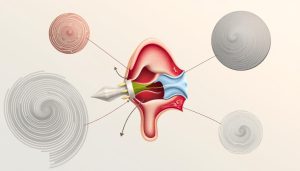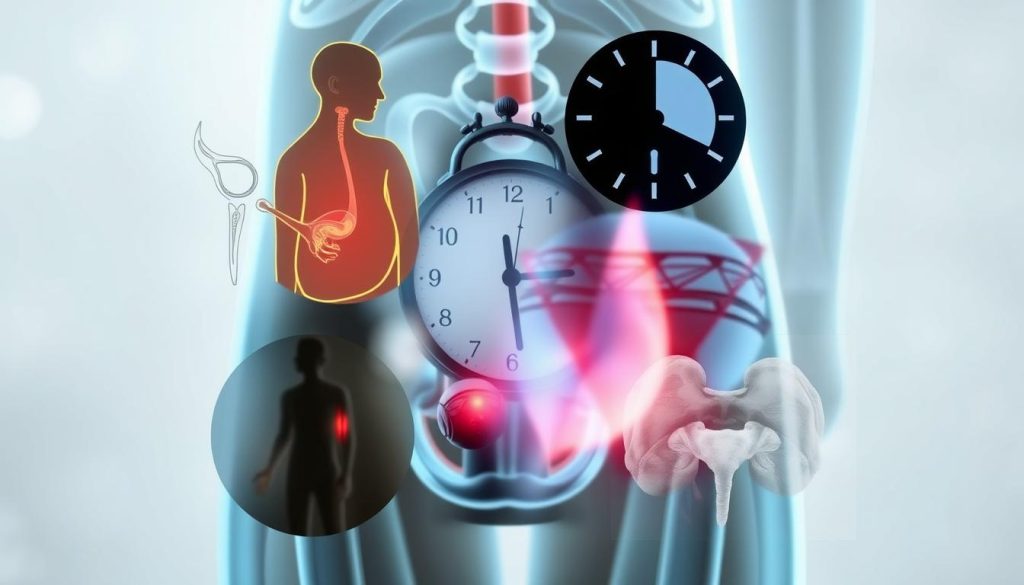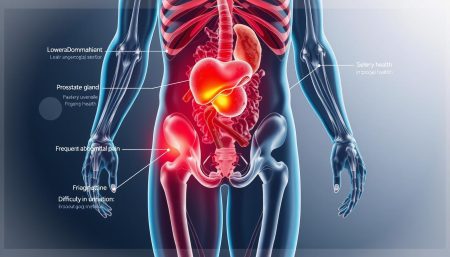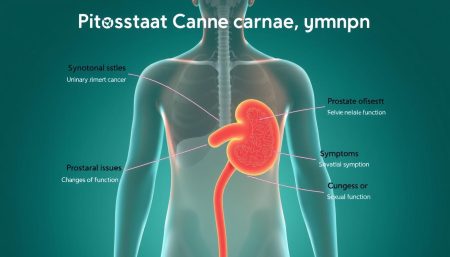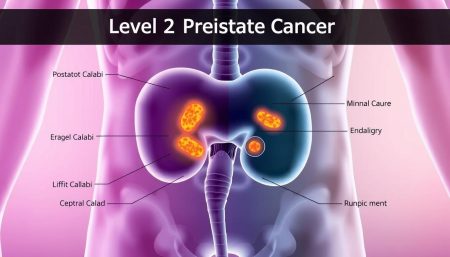Prostate cancer is a silent threat that affects countless men worldwide. Recognizing the warning signs of prostate cancer can be crucial for early detection and treatment. This article delves into five key symptoms that shouldn’t be ignored.
While prostate cancer symptoms may not always be obvious, being aware of potential red flags can make a significant difference. From changes in urinary habits to unexplained pain, these signs could indicate the need for medical attention. Let’s explore these warning signs to empower you with knowledge that could potentially save lives.
Understanding Prostate Cancer: Essential Facts and Statistics
Prostate cancer is a serious health issue for men around the world. It starts in the prostate, a small gland in the male body. We’ll look at important facts, risk factors, and why early detection is key.
What is Prostate Cancer and Who’s at Risk
Prostate cancer happens when prostate cells grow too much. Factors like age, family history, and race play a role. Men over 50, those with a family history, and African American men are at higher risk.
Current Statistics and Prevalence Rates
Prostate cancer is the second most common cancer in men worldwide. In the U.S., about 1 in 8 men will get prostate cancer. Thanks to better screening and treatment, survival rates have gone up.
| Age Group | Prostate Cancer Risk |
|---|---|
| Under 40 | 1 in 10,000 |
| 40-59 | 1 in 41 |
| 60 and older | 1 in 6 |
The Importance of Early Detection
Early detection is vital for treating prostate cancer well. Regular check-ups, like PSA tests and prostate exams, can find the disease early. Men should talk to their doctors about screening, especially if they have risk factors or symptoms.
“Early detection saves lives. Regular screenings for prostate cancer can make a significant difference in treatment outcomes and quality of life.”
Knowing about prostate cancer and its risks helps men take care of their health. Regular check-ups and talking to doctors are important for managing prostate health.
What Are the 5 Warning Signs of Prostate Cancer
Spotting prostate cancer early is key to effective treatment. Men should know five important signs that might mean they have prostate cancer. These signs can help men talk to their doctors and get checked early.
- Urinary changes
- Erectile dysfunction
- Blood in urine or semen
- Pelvic discomfort
- Unexplained weight loss
It’s important to remember that these signs don’t always mean cancer. Other health issues can cause them too. Knowing these signs helps men stay on top of their health.
| Warning Sign | Description | Action |
|---|---|---|
| Urinary changes | Frequent urination, weak flow, difficulty starting or stopping | Consult urologist |
| Erectile dysfunction | Difficulty achieving or maintaining an erection | Discuss with doctor |
| Blood in urine/semen | Pink, red, or brown-tinged urine or semen | Seek immediate medical attention |
| Pelvic discomfort | Pain or pressure in pelvic area | Schedule medical evaluation |
| Unexplained weight loss | Losing weight without changes in diet or exercise | Undergo comprehensive health check |
Knowing the 5 warning signs of prostate cancer lets men take control of their health. If you notice any of these signs, see a doctor right away. This is crucial for early detection and treatment of prostate cancer.
Urinary Symptoms as Key Indicators of Prostate Problems
Changes in urination can signal prostate issues. Men should watch for these signs, as they might point to prostate cancer. Catching it early is key to better outcomes, so it’s important to know the warning signs.
Frequent Urination Patterns
Frequent urination, especially at night, is a common sign. Waking up often to use the bathroom is a red flag. This can mess up your sleep and daily routine.
Difficulty Starting or Stopping Urination
Problems with starting or stopping urine flow are signs of prostate issues. You might have a weak stream, dribble, or feel like your bladder isn’t empty. These symptoms can be annoying and might mean an enlarged prostate or other problems.
Blood in Urine: When to Be Concerned
Seeing blood in urine is scary and needs quick medical help. It doesn’t always mean cancer, but it’s serious. Infections or kidney stones could also cause it, but checking for prostate cancer is crucial.
“Prostate cancer is common but can be curable, especially when identified and treated early.”
Painful urination is another symptom to watch for. It might feel like burning or stinging. If you notice any of these symptoms, see your doctor. Early action can greatly improve prostate health.
Physical Discomfort and Pain Signals
Prostate cancer can show itself in many ways. Spotting these signs early is key for better treatment. Let’s look at some important signs that might point to prostate issues.
Lower Back Pain and Pelvic Discomfort
Lower back pain is often ignored but can be a sign of prostate trouble. This pain might spread to the pelvic area, causing a constant ache. Not all back pain means cancer, but if it gets worse, see a doctor.

Bone Pain in Advanced Stages
In later stages, prostate cancer can spread to bones. This can cause pain in bones like the hips, spine, or ribs. If you have bone pain that won’t go away, see your doctor right away.
Sexual Function Changes
Changes in sex life can be an early sign of prostate problems. Erectile dysfunction is a common symptom. It’s important to talk to your doctor about any changes to check for serious issues like prostate cancer.
- Difficulty achieving or maintaining an erection
- Decreased libido
- Pain during ejaculation
These symptoms don’t always mean prostate cancer. Many things can cause similar pain. But, if you notice these signs, especially if they get worse, get checked by a doctor.
Changes in Body Function and Performance
Prostate cancer can show up in unexpected ways, affecting how our bodies work and perform. It’s key to spot these signs early for quick action.
One big symptom is unexplained weight loss. Men might lose a lot of weight without changing their diet or exercise. This weight loss often comes with other body changes that can mess with daily life.
Fatigue is another sign that’s not to be ignored. Feeling tired all the time, even after resting, could mean something serious like prostate cancer. This tiredness can hurt your work, social life, and overall happiness.
Some men notice changes in how hungry they feel. Feeling less hungry or feeling full too quickly can be a worry, especially with other symptoms.
“Any unexplained changes in your body, particularly unexplained weight loss, should prompt a discussion with your healthcare provider.”
These symptoms can mean different things. But if you have them along with urinary problems or other prostate symptoms, see a doctor fast.
| Symptom | Possible Indication | Action Required |
|---|---|---|
| Unexplained weight loss | Potential sign of prostate cancer | Consult a doctor |
| Persistent fatigue | May indicate systemic effects of cancer | Seek medical evaluation |
| Changes in appetite | Could be related to cancer progression | Discuss with healthcare provider |
By paying attention to these body changes and telling a doctor right away, men can take care of their health. This helps catch prostate cancer symptoms early.
Screening Methods and Diagnostic Tools
Prostate cancer screening is key for early detection. Let’s look at the main ways doctors check for this disease.
PSA Testing: Understanding Your Numbers
PSA levels are important in prostate cancer screening. This blood test checks the prostate-specific antigen in your blood. High levels might mean prostate problems, but not always cancer.
Your doctor will look at these numbers with your age and health in mind.
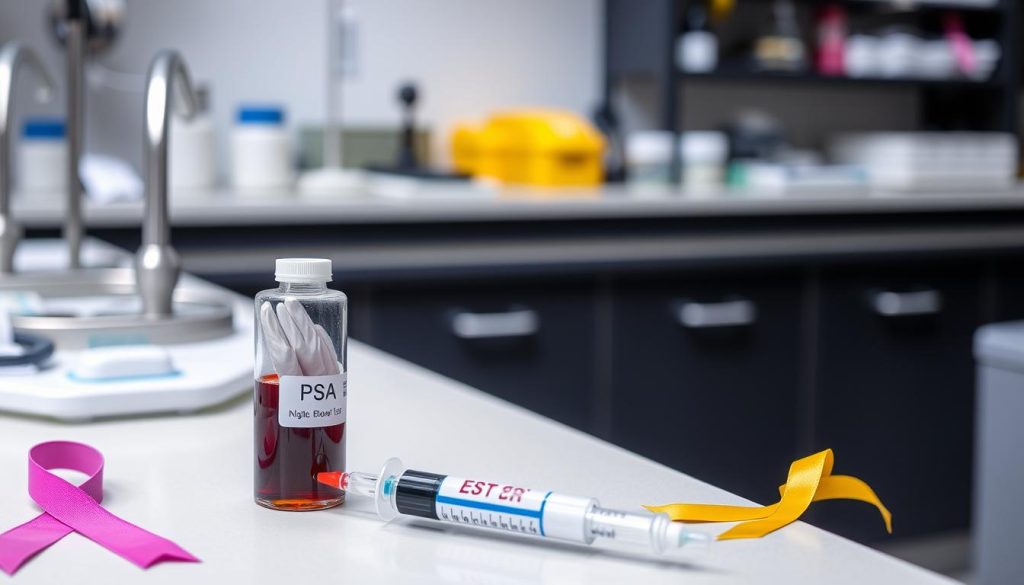
Digital Rectal Examination (DRE)
The DRE is a physical exam where a doctor checks your prostate by hand. They feel for any lumps or hard spots that might suggest cancer. It might feel a bit uncomfortable, but it’s a quick test that helps a lot with your prostate health.
Advanced Screening Technologies
New tools are making prostate cancer detection better. These include:
- MRI scans to create detailed images of the prostate
- PET scans to track cancer spread
- Biomarker tests to analyze genes linked to prostate cancer
These advanced methods help doctors make more accurate diagnoses and treatment plans. Regular prostate cancer screening, starting with PSA tests and DREs, can lead to early detection and better outcomes. Talk to your doctor about which screening options are right for you.
When to Seek Medical Attention
It’s important to know the warning signs of prostate cancer early. If you notice changes in how you pee, pain, or blood in your urine, see a doctor. These symptoms should not be ignored, even if they seem minor.
Regular check-ups help keep an eye on your prostate health. Men over 50 or with a family history of prostate cancer should talk to their doctor about screenings. Don’t wait until symptoms get worse. Early action can greatly improve treatment results.
Not all prostate cancer signs are clear. Some might be subtle or easy to overlook. If something doesn’t feel right, make an appointment with your doctor. They can run tests and offer advice. Your health is worth it.
Being aware of prostate cancer symptoms and getting medical help quickly is crucial. Regular screenings and talking openly with your healthcare team are your best defense. This approach can help prevent this common but treatable cancer.
FAQ
Q: What are the 5 warning signs of prostate cancer?
A: The 5 main warning signs of prostate cancer are: 1) Frequent or difficult urination, 2) Blood in urine or semen, 3) Erectile dysfunction, 4) Pain in the lower back, hips, or pelvis, and 5) Unexplained weight loss. These symptoms can also be caused by other conditions. Always consult your doctor for proper diagnosis.
Q: At what age should men start getting screened for prostate cancer?
A: The American Cancer Society suggests that men talk to their doctor about prostate cancer screening at age 50. For high-risk men, including African Americans and those with a family history, it’s age 45. For those at even higher risk, it’s age 40.
Q: What is a PSA test and what do the results mean?
A: A PSA test is a blood test that measures PSA levels. PSA is a protein from the prostate gland. Normal PSA levels are under 4 ng/mL. Levels over 4 ng/mL may indicate cancer or other conditions. Always discuss your results with a healthcare professional.
Q: Can prostate cancer be cured if detected early?
A: Yes, early detection of prostate cancer leads to a high cure rate. The American Cancer Society says the 5-year survival rate for localized prostate cancer is nearly 100%. Regular screenings and prompt medical attention are key to successful treatment.
Q: Are there any lifestyle changes that can help prevent prostate cancer?
A: While there’s no sure way to prevent prostate cancer, some lifestyle changes may help. Eating a healthy diet, exercising, and maintaining a healthy weight are beneficial. Limiting alcohol and not smoking also helps. Foods rich in lycopene and omega-3 fatty acids may have protective effects.
Q: How is prostate enlargement different from prostate cancer?
A: Prostate enlargement, or BPH, is a non-cancerous condition where the prostate grows larger. It can cause similar symptoms to prostate cancer but is not life-threatening. Because symptoms can be similar, it’s crucial to get a proper diagnosis from a doctor.











